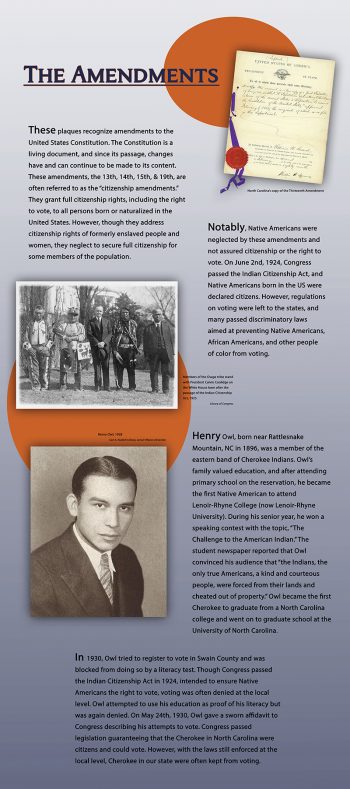By SCOTT MCKIE B.P.
ONE FEATHER STAFF
Not only did the Cherokee Chamber Singers dazzle the audience with their performance in Raleigh last fall, they ended up affecting social change at the North Carolina State Capitol Building.
While in Raleigh, the students took a tour of the Capitol, led by Kara Deadmon, North Carolina State Capitol museum curator. The tour included a talk about citizenship rights and voting rights, and several students pointed out that the information portrayed left out Native Americans.
“My initial reaction was wow – these kids are absolutely right, and we should absolutely include the history of citizenship rights for Native Americans in our story,” said Deadmon who made an information panel discussing the information that will be placed permanently on the first floor of the Capitol near the Offices of the Governor. “I was in awe of their authority, and I was humbled. It was a gut punch to me, in the best possible sense, to have these students teach me that I need to do better, and that the Capitol can and will do better.”

The image shows a new, proposed panel for the North Carolina State Capitol display on constitutional amendments that contains information relating to citizenship and voting rights for Native Americans. Cherokee High School students were instrumental in calling attention to the fact that this information was not previously shown in the display.
The information panels currently address the “citizenship amendments” to the U.S. Constitution (13th, 14th, 15th, and 19th), but do not address Native Americans. The proposed added panel, developed by Deadmon, will state, “Notably, Native Americans were neglected by these amendments and not assured citizenship or the right to vote. On June 2, 1924, Congress passed the Indian Citizenship Act, and Native Americans born in the U.S. were declared citizens. However, regulations on voting were left to the states, and many passed discriminatory laws aimed at preventing Native Americans, African-Americans, and other people of color from voting.”
Deadmon noted, “The Capitol’s history, what we tell our visitors on tour, and what is exhibited around the building, should reflect the public that we are now serving. It’s true that for much of this building’s history, this was not an inclusive space. The building’s construction was completed using enslaved labor in the 1830s. When it opened in 1840, it was a space designed for powerful white men. Even after African-American men were enfranchised in 1868, there were those that worked to bar them from access to this space. By 1900, codified segregation kept people of color from voting and serving in our state’s legislature.”
She added, “Even today, with universal citizenship rights secured, we often don’t tell an inclusive, dynamic story in our historic spaces. It is crucial that the history of this building, which remains the active Capitol of the State of North Carolina, details the history of all of our state’s people…”
Kimberly Hendrix, Silas Driver, and Maiya Davis, all juniors at Cherokee High School and members of the Cherokee Chamber Singers, were on the tour that day with Deadmon. “We noticed it was all just black and white and there was nothing about Native Americans there,” said Hendrix. “It makes me really happy to know that we’re not just singing for entertainment, we’re actually inspiring people to make a change. There’s not a lot of Native American culture shown in the area outside of Cherokee.”
She noted that the panel project is a great way to show more of Native American history, “I think we need that, and I want people to know that, and it makes me feel happy that we made a change to start that.”
Davis commented, “It made me happy to know that we were in that kind of position. We’re just high school students and we touched her (Deadmon) heart and were able to make that change.”
Driver noted, “I like the fact that we’re high schoolers and were able to make a difference.”
Deadmon commented on the importance of this first step, “I think it’s essential that we stress the importance of voting to all our visitors, children and adults. Though some might consider voting to be an inherent right or freedom today, we have to remember those that came before, who fought for the enfranchisement of marginalized groups. Children of all ethnic backgrounds benefit from a contextual knowledge of this struggle.”
A part of the new panel being developed by Deadmon includes information about the late Henry Owl, a member of the Eastern Band of Cherokee Indians who was the first Cherokee to graduate from a North Carolina college. The panel discusses his struggles in gaining the ability to vote after being denied his right to register to vote in Swain County in 1930 – six years after Native Americans were granted citizenship.
The panel states, “Owl attempted to use his education as proof of his literacy but was again denied. On May 24, 1930, Owl gave a sworn affidavit to Congress describing his attempts to vote. Congress passed legislation guaranteeing that the Cherokee in North Carolina were citizens and could vote. However, with the laws still enforced at the local level, Cherokee in our state were often kept from voting.”
Deadmon said she’s awaiting feedback from the Cherokee students on the proposed panel. Once a final panel is set, she plans to have them printed and installed immediately.





